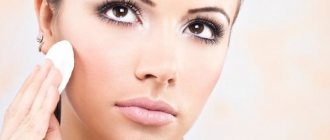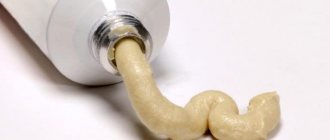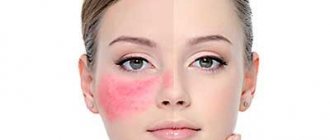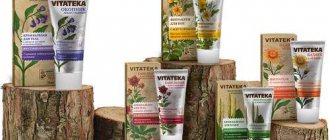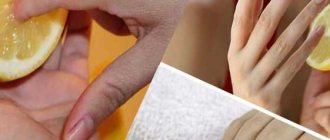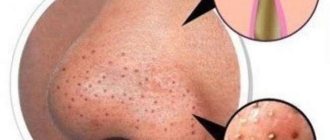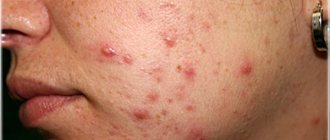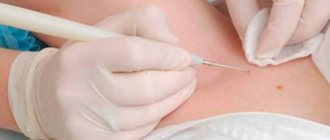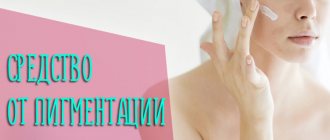Author: Irina Lazur
Last modified: 2020-07-21 Date written: 2016-09-28
A pigment spot is not just an annoying cosmetic defect; often the appearance of pigmentation is associated with a malfunction of internal organs.
The article talks in detail about the types of stains and the reasons for their appearance. How to get rid of this yourself using “home” recipes, and in what cases is it better to consult a specialist?
Skin pigmentation is a signal that something is wrong
Not everyone knows that age spots are not just a cosmetic problem. The condition of the skin directly depends on the functioning of internal organs and systems, therefore it makes no sense to fight any cosmetic problems only with the help of a variety of creams and masks.
Such methods are a necessary and important addition to complex treatment. The choice of treatment method should be based on the cause of pigmentation formation and requires a mandatory examination of the body.
The use of special products for external use gives the result - the spots may turn pale and decrease in size.
But such measures are usually not enough, since even the most expensive cream from a reputable manufacturer is not able to eliminate the cause of this cosmetic defect. Over time, the spots appear again and, often, they become even more pronounced.
Why are there pigment spots on the face?
Pigmentation occurs in both young, middle-aged and elderly people. Most often, spots form between 40-50 years of age.
In some cases, the spots disappear spontaneously without treatment, but this is an extremely rare occurrence. Usually, pigmentation tends to increase and getting rid of it requires enormous effort.
Pigment spot - what is it?
This is an accumulation of melanin substance.
Reference. Melanin is a special pigment localized on different layers of the epidermis.
In cases where melanin is concentrated closer to the top layer of the skin, they speak of moles or freckles. Moles and freckles can be pale in color, or they can be light yellow or deep brown.
What is hyperpigmentation?
The deposition of melanin in the deep layers of the skin is hyperpigmentation.
External manifestation:
Spots on the skin that can be of different sizes and shapes, and even rise above the surface. The shade is more saturated - from medium brown to dark brown.
Types of pigmentation. Medical classification
- freckles;
- chloasma;
- lentigo;
- birthmarks (moles).
Causes of formation - increased synthesis of melanin
Why is melanin synthesis activated?
There are many reasons:
Hereditary (genetic) factor. It is the result of a genetic predisposition and is usually diagnosed at birth. Severe pigmentation can be treated with modern surgical techniques (for example, laser resurfacing).
Hormonal imbalance in the body. Such pigmentation can be quite noticeable and is a consequence of hormonal changes associated with the menstrual cycle, pregnancy, the postpartum period, and hormonal imbalance due to any disease.
The pigmentation is called chloasma. Experts do not recommend self-treatment in this case, since it is important to accurately establish the diagnosis and conduct a course of treatment for the underlying disease.
For example, with some endocrine pathologies, characteristic pigment spots appear, which are caused by a malfunction of the endocrine system. There are a number of factors that result in pigmentation on the skin, by which an experienced specialist can diagnose the disease.
These are some women's problems, malignant tumors of the pituitary gland, malfunction of the thyroid gland, etc. The course of treatment for the underlying disease leads to a gradual normalization of hormonal levels, so the spots become smaller and lighter.
Mechanical damage to the skin. Pigment spots are formed as a result of attempts at illiterate treatment of acne, with chronic and severe furunculosis, due to exposure to chemical and thermal factors (burns), as well as peeling, etc. and so on.
The intensity varies and directly depends on many components - the characteristics of the skin of a particular patient, the degree and depth of the injury. Often, local treatment with creams and other methods in such cases is not enough, so complex complex therapy must be prescribed.
Aggressive exposure to ultraviolet radiation. Sun rays are a common cause of pigmentation in varying degrees of manifestation, including severe cases. This is not just an unpleasant cosmetic defect, but an alarming sign.
Ultraviolet radiation in high doses is dangerous to health and even life and is the main cause of the formation of malignant neoplasms of both the skin and internal organs. The face is the area where this type of pigmentation is most common, since the skin of the face is thin and delicate.
The substance melanin is necessary for the body; its main task is to provide reliable protection against adverse external factors. Therefore, with the active production of melanin, the skin becomes darker. This measure serves as a natural protection against burns. When a person abuses treatments in a solarium or sunbathing, pigmentation may be unevenly distributed, resulting in this defect.
The rays of the sun are especially dangerous in the spring, when the heat is not yet felt. In addition, in spring the skin is partially depigmented. The use of special protective equipment in the spring and summer is a mandatory measure, but such methods do not always give results. If you are prone to the formation of age spots, you should not be in direct sun for even a short period of time.
Gastrointestinal diseases and kidney pathologies (liver, gall bladder and intestines). The formation of pigment spots of a slightly reddish color is characteristic of indigestion; brown spots more often appear with a common diagnosis of cholecystitis and with various diseases of the liver and gall bladder.
Problems with kidney function are signaled by the appearance of yellowish-brown pigmentation. Monotherapy is not necessary for such diagnoses. After examinations and proper therapy, as well as following a special diet, the spots disappear on their own as the health status stabilizes.
Chronic stress and mental illness. The appearance of pigmentation is explained by hormonal imbalance and general metabolic disorders. These spots come in different colors, shapes and sizes.
Deficiency of vital vitamins or minerals. This is a fairly common reason; treatment consists of correcting nutrition, taking vitamin and mineral complexes, changing lifestyle and giving up bad habits. For example, with a lack of vitamin C (ascorbic acid) or an element such as copper, the appearance of age spots is a common occurrence.
Use of certain medications, especially uncontrolled or prolonged use. Pigmentation may appear after treatment with certain types of antibiotics. If pigment spots appear that were not there before while taking such medications, you should inform your doctor about this.
Allergic manifestations due to the use of low-quality or inappropriate cosmetics and care products. Creams, lotions, decorative cosmetics are a provoking factor, which in many cases causes the appearance of pigment, skin rashes, etc. Typically, such manifestations are visible immediately after using any drug for a similar purpose, so the issue of diagnosis is not acute here.
Stains can cause:
- Natural concentrated essential oils;
- Cheap, low quality ingredients (especially in decorative cosmetics);
- Excessively aggressive skin cleansing with scrubs and other preparations designed to deep clean the skin.
Skin aging
At a certain age (after 40-50 years and older), some people develop characteristic age spots, which are located on the face, neck, and hands. This is the result of the active synthesis of melanin and a consequence of its uneven distribution in the layers of the skin, as well as changes in hormonal balance and natural aging of the body and skin in particular.
In addition, pigmentation at this age can be a consequence of the appearance of various chronic diseases. This manifestation usually does not pose a danger to humans, but requires more careful monitoring of the state of health.
Types of age spots on the face
Some pigments are responsible for the color of human skin: melanin, bilirubin, hemoglobin, etc. In cases where their number increases or decreases, similar problems arise.
There are several varieties:
- Freckles. The most common type of pigmentation. Light-skinned people are especially susceptible to it. They appear after prolonged exposure to ultraviolet radiation, as a result of which the pigment collects unevenly on different areas of the skin. Appear on the face, neck, chest, arms. They can be small to brown in large numbers. As a rule, during cold periods they disappear or turn pale. With increasing age, their intensity becomes less.
- Nevi are spots (birthmarks), intensely colored areas with smooth edges. The reasons for the appearance, as with other types of pigmentation, are the unequal distribution of coloring cells. The coloring ranges from beige to brown with dark tones. The phenomenon of growth of such spots should cause alarm; there is a possibility of degeneration into oncology.
- Dyschromia during gestation . Pigmentation appears quite often during pregnancy. The color intensity and location vary. After childbirth, such spots disappear. But there are times when they remain, and then cosmetic help is needed.
- Chloasma – are large pigment spots located on the face and predominantly occur in young people. They have uneven outlines, gradually unite, turning into one large spot of involuntary shape. Localized on the neck, ears. They practically do not extend to the décolleté area. Under ultraviolet light the size increases. Hormonal imbalance is the main cause of such spots.
- Vitiligo – spots that cannot be treated because they have not been fully studied. Rarely found. People with albinism (another name for vitiligo) lack or partially have cells that produce melanin. As a result, discolored (no pigment) spots are formed. If such spots are present, it is not recommended, and often even prohibited, to be in the sun. When exposed to sunlight, they can develop into cancer.
Separately, age-related pigmentation is distinguished. It is characterized by dark brownish spots of varying sizes. They appear under excessive exposure to solar ultraviolet radiation. They are characterized by the fact that they do not change color under the influence of any factors. For example, like freckles at certain times of the year.
Age-related pigmentation occurs when hormonal balance changes due to the onset of menopause.
Interruptions in liver function can also be a cause. Highlight:
- Lentigo – pigmentation characteristic of older people. Most often they appear in places exposed to prolonged exposure to the sun, in places where there is a sunburn. With menopause, lentigo increases.
- Keratoma is a round plaque with a scaly structure. Mainly gray in color with a yellowish tint. There is a possibility of conversion to oncology education. Its removal is recommended.
- Spotty pigmentation (senile freckles) appears on the shoulders and hands.
- Xanthoma of the eyelids - spots appear under the eyes, or in the inner corners.
Pigment spots on the body: photos and causes
Given the wide variety of causes, such rashes can be located in different parts of the torso and limbs. If the red formations itch, this may indicate an allergic reaction.
Among the factors why and why pigment spots appear on the body are:
- Hormonal changes. For example, pigment spots after childbirth and during pregnancy, judging by the photo, form in many women.
- Aging of the body.
- Pathologies of the liver and biliary tract.
- Exposure to ultraviolet radiation.
- Stress.
- Use of perfumes and cosmetics.
- Squeezing pimples and blackheads.
- and many others.
Causes of pigmentation
Pigmentation on the face: causes and treatment (which will be discussed below) are determined by a specialist. Their appearance is a process of increased occurrence of pigment in the skin.
The zones may be light, reddish or dark. The shape ranges from smooth to uneven. They have hereditary causes or are acquired. In such areas, the skin becomes drier, rougher and prone to wrinkles.
Common causes of pigmentation:
- Heredity. Passed on by inheritance, it can manifest itself even at a young age.
- Lack of vitamins. Melanin is also produced with the help of vitamins; with their deficiency, the skin is more susceptible to external negative factors and brownish spots appear.
- Ultraviolet radiation is the main cause of such manifestations.
- Pregnancy and the postpartum period occur under the influence of changes in a woman’s hormonal balance.
- Disturbed functioning of internal organs. As a rule, liver, kidneys, stomach.
- Formation of spots as a result of improper treatment of acne.
- Changes in hormonal balance in general.
- Stressful conditions.
- Incorrectly selected cosmetics, the components of which can cause allergic reactions.
The use of pharmaceutical products against pigmentation
With the permission of the attending physician, women over 40 years of age whose cause of severe pigmentation on the face are age-related changes can use the following products to lighten their skin:
- Hydrogen peroxide. It is allowed to use only a 3% solution after consulting a doctor. A small amount of hydrogen peroxide should be applied only to problem areas of the skin. The product must be used very carefully, as it can injure the dermis and cause even more problems with the facial skin;
- Cream containing mercury. This remedy is also used only with the permission of a doctor. Therapy with mercury creams can only be carried out for a few days, since long-term use is fraught with the development of a severe allergic reaction. The product is strictly contraindicated for women during pregnancy and breastfeeding;
- Paste with zinc. Zinc cream-pastes have the most gentle effect on the skin, while they help not only lighten the skin, but also smooth out fine wrinkles and eliminate pimples and acne.
Any of the above products can be purchased at the pharmacy. In case of strong pigmentation, they are allowed to be used by younger women - after 30 years. But self-medication can lead to irreparable consequences. All therapeutic actions can be carried out only after consulting a doctor.
In this article, we looked at how pigmentation on the face can be treated. It is important not to delay the treatment of skin pigmentation on the face, as in some cases it can be a sign of a skin disease. At the first appearance of age spots, it is strongly recommended to seek medical help. Only a doctor can choose the appropriate treatment. Severe pigmentation on the face requires immediate treatment measures, as it may be one of the symptoms of a hidden dangerous disease.
Is it possible to get rid of age spots forever?
Pigmentation on the face: causes and treatment are established with the help of qualified help if the causes are really serious. If spots appear as a result of external factors, it is recommended to use ointments, creams or oils, which are widely available. The main attention is paid to the quality of specialized cosmetics and the individual characteristics of the skin.
In addition to cosmetics, a number of cosmetic procedures are offered to eliminate this problem. They have a permanent effect.
These include:
- phototherapy;
- chemical peeling;
- cryotherapy;
- laser peeling;
- dermabrasion;
- ultrasonic peeling.
Using skin lightening products
Pros and cons of skin lightening products
Each specialized care product has certain advantages and disadvantages. To give an assessment, they need to be compared with something. In this case, the comparison will be carried out in parallel with home remedies and specialized procedures. The main characteristic of bleaching agents is that they are effective, but the result is not immediately visible.
Positive sides:
- Compared to specialized procedures, creams are a more gentle method; there is no trauma to the deep layers of the skin.
- Practical to use, you can use it anywhere.
- They cope with pigmentation completely, with parallel skin care.
- Some components may have an additional effect on eliminating wrinkles and relieving irritation.
- Affordable compared to specialized procedures.
Disadvantages of using such bleaching agents:
- Expected results in at least a week.
- The course of use is about a month.
- Danger of presence of hazardous components. Some toxic components can cause allergic reactions or even damage.
- Home remedies are comparatively cheaper than industrial ones.
Whitening products
All industrially produced whitening creams are divided into three groups:
- Contributing to blocking the production of melanin - since they affect melanocytes, their function is inhibited and reappearance is blocked.
- With a brightening effect.
- With dual function: brightening and obstruction.
Treatment for pigmentation on the face begins only after the causes have been established.
Among the wide variety of industrial, specialized products, the following popular creams are distinguished:
- Cream from Vichy - Vichy Idealia PRO . Combines effectiveness and safety (absence of harmful components). The action is aimed at removing dark spots and cell production. Ingredients: kombucha, water (thermal), acid (salicylic), adenosine. Suitable for irritated, sensitive, dry skin.
- Evinal - action is aimed at all types of stains. Can be used under sun protection. Ingredients: placenta, parsley, corn oil, calendula.
- Elure from Syneron Medical. The main component is Melanozyme. It eliminates pigment in the skin layers. Available in 2 packages and provides for use in 2 stages: first, the affected areas are treated, and then the entire face, to completely destroy melanin.
- Achromin is produced by the company Alen Mak-Bulgaria - its action is aimed at removing melanin from cells. Effective for freckles. Not recommended for use by pregnant women and those with sensitive skin. Supposed side effects: causes dryness, there may be rashes and redness. Do not use for acne, avoid use by children. Before use, consult a cosmetologist.
- Clotrimazole is a universal remedy for eliminating pigmentation. Effective against inflammation. Relatively inexpensive cost and high efficiency of use. It is considered hypoallergenic, but individual allergies to the components of the drug are possible. Not recommended for pregnant women.
- Neotone Radiance - a cream with a light texture, especially suitable for sensitive skin. Can be used as a prophylactic agent in the summer. Has great protection from sun rays. Contains licorice root, glycolic and salicylic acids.
- Bielita Vitex actively eliminates pigmentation and can even affect dark spots. Fruit acids in the composition are able to eliminate exfoliated cells. Can be used as prophylaxis. There are no harmful components in the composition.
Terms of use
Since the products are specialized, you need to familiarize yourself with the rules for using such cosmetics:
- Before use, even if the drug contains only harmless components, it is necessary to test for allergic reactions. Apply a certain amount to the inside of your hand and leave for a quarter of an hour. Use is permissible in the absence of any skin reactions.
- Application is envisaged in autumn, winter and spring, when the sun is less active.
- Apply a thin layer to cleansed skin.
- Apply once or twice, according to the instructions.
- Parallel use of home whitening products is allowed.
- Limit exposure to the sun and use additional protective equipment.
Selection rules
Before purchasing, you need to thoroughly study the offered options, get advice and familiarize yourself with the composition of the cream.
Rules:
- The main rule is to choose taking into account the personal characteristics of the skin. The action of the components is aimed at whitening; if used incorrectly, unwanted side effects may occur.
- Consider age, size and degree of pigmentation.
When choosing a method of treating pigmentation on the face, the causes of its occurrence must be taken into account (heredity, gastrointestinal diseases, excess ultraviolet radiation, etc.) - It is recommended to use creams without harmful ingredients, mainly with a high content of natural ones, which soften chemical ones.
- If a quick result is promised, and the composition contains kojic acid or hydroquinone, you should refrain from purchasing. These toxic substances act quickly and harm the skin.
Don't miss the most popular article in the section: Amaranth oil - properties and use in cosmetology, reviews, price of the product.
A complex approach. UV protection and pigmentation treatment
Any problem should be approached comprehensively, and the treatment of hyperpigmentation is no exception.
The high effectiveness of complex cosmetic preparations in the treatment of age spots has been clinically proven.
Such drugs act in two directions:
- Provide protection from aggressive ultraviolet radiation.
- They provide therapeutic and cosmetic local results.
Complex product Neotone . Includes Neoton in the form of a serum (using modern ingredients - alpha-arbutin, Lumiskin and licorice), which is intended for skin care before bed, as well as a morning preparation - Radiance (with a high degree of protection - SPF50+).
This is a popular product with a high effect, time-tested; the manufacturer has provided a whole line of modern products that provide all stages of skin care.
It is effective against stains of various origins and is both a medicinal and a cosmetic care product that can act as a safe prophylactic agent.
Cosmetic procedures
Laser peeling
Pigmentation on the face (the causes and treatment are determined by a specialist) can be eliminated using a cosmetic lightening procedure - laser peeling.
It is performed in two variations, depending on the type of laser and its action:
- The first one works on carbon dioxide - CO2 laser peeling is deep. With certain settings it is capable of cutting fabric;
- Erbium - the laser beam passes through erbium (a chemical element) and affects dead skin cells without deep penetration. The skin is not damaged upon exposure.
There is cold and hot laser resurfacing - another division into varieties:
- When it is cold, the cells are removed in layers without heating the lower layers. Like simple exfoliation;
- When hot, in addition to the main function, rejuvenation occurs by stimulating collagen production. This method heats the lower layers.
Ultrasonic peeling
Pigmentation on the face using ultrasonic cleaning is carried out after identifying the cause using a special device that produces waves of certain frequencies, and they are safe. Treatment involves removing the top layers of skin. A repeat procedure is recommended after 2 weeks.
Occurs in several stages:
- Treatment of the skin with water (mineral), which is designed to cleanse the skin.
- Treatment with a device that helps open pores and cleans them.
Chemical peeling
Superficial skin burn with the use of acids: glycolic, fruit, trichloroacetic and salicylic. Depending on the degree of its concentration, it is classified as superficial or deep.
Superficial peeling
For superficial applications, a weak concentration of fruit acid is used. Operating principle: removal of the top layer of dead cells along with pigmentation. The main advantage is a low degree of injury and painlessness. There is some burning sensation, and over time, peeling of the skin is observed.
The main rule after the procedure, in order to avoid the formation of new spots, is to avoid direct exposure to sunlight.
Deep peeling
Deep peeling is carried out using trichloroacetic or salicylic acid. This is a more traumatic method, but it helps to effectively get rid of spots and even small wrinkles, smooth the skin and even out the complexion.
Before the procedure, an examination is carried out, a peeling agent is selected, and the need for anesthesia is used. It is necessary to choose the right type of peeling and post-peel care.
Dermabrasion
Dermabrasion is a mechanical peeling that involves deep grinding of the skin. A very tough but effective procedure. Helps get rid of defects forever. There are several types, depending on the depth of exposure and the equipment used. The procedure is carried out only if there is no inflammation.
It is carried out in several stages:
- cleaning and highlighting the necessary areas with a marker;
- anesthesia;
- placing ice containers on areas;
- using the selected nozzle, grinding is carried out;
- freezing with a special spray to remove exfoliated layers;
- applying a bandage to stop bleeding (during deep grinding);
- The recovery period lasts up to a month.
Phototherapy
Promotes the destruction of cells with a high content of melanin pigment by exposing the skin to flashes of infrared rays of a special length. The spot, receiving a wave of light, acquires a lighter shade and soon disappears completely. The method is painless: the spots disappear without damaging the skin. This method involves getting rid of pigmentation in several procedures.
Stages of implementation:
- The skin type and the depth of the lesion are considered. The duration of treatment and the type of radiation are established;
- establishing the absence of contraindications;
- During the procedure, glasses are put on the eyes to protect from burns;
- cleaning is carried out;
- application of anesthetic and gel with a cooling effect;
- using the device, pulses are processed, melanin is destroyed and separated by peeling;
- Applying a soothing redness reliever to hydrate.
Cryotherapy
The principle of the method is to eliminate stains under the influence of liquid nitrogen. Upon contact with the stain, surface cells are destroyed and restoration is stimulated.
Since the skin is injured, redness is observed for some time.
The following stages of the procedure are distinguished:
- cleaning areas;
- treatment with nitrogen, spray or swab (cotton);
- the area swells, after a few days it shrinks and peeling occurs.
Whitening in salons
Whitening is carried out by mechanical, laser and chemical peeling.
Traditional medicine methods
Pigmentation on the face (the causes and treatment can be determined independently in some cases) can be effectively eliminated using folk methods. All modern methods of getting rid of this problem are widely used. But earlier, in the absence of such procedures, women resorted to improvised folk methods and coped with it quite effectively.
Effective means include:
- Lemon juice. Mix a spoonful of juice with liquid (10 spoons) and use it for wiping. As a mask: mix milk and juice in equal parts with 20 g of yeast.
- Cucumber juice. Use regular wiping. Grate the cucumber and use the pulp after the juice as a mask. You can cut it into thin pieces and put it on your face. This product not only brightens, but also moisturizes.
- Parsley. Brew parsley and wipe your face daily. For a tonic effect, make ice cubes from the broth. For the winter, prepare parsley sprigs and, if necessary, make cosmetic ice.
- Melon. Melon skin compresses.
- Egg shells. Grind into powder, mix with milk or kefir, use once a week as a scrub.
- Onion juice. After application, let it sit, rinse and apply sour cream for a while. It is better to do such manipulations at night.
- Olive oil has a brightening effect and also nourishes the skin.
- Rice broth. Strain the boiled rice, make ice cubes from the liquid and wipe twice.
- Bulgarian pepper. Use the paste as a mask.
- starch with lemon juice and leave for a quarter of an hour after application.
More complex mask components:
- Mix dry yeast, grapefruit juice, hydrogen peroxide 3%, lemon juice in equal parts.
- Grind parsley, cucumber, currants (red), dandelion (leaves), lemon, white clay, pomegranate using a food processor. After use, wipe your face with ice.
- Grind oat flakes, mix with strawberries and sour cream.
Before using masks, the skin should be clean, ideally steamed. After the procedures, wash your face with cold water or wipe your skin with ice to close the pores.
Removing pigmentation on the face is sometimes a long, but worthwhile procedure. After accurately identifying the reasons, you can immediately wait for the result of the treatment and enjoy the effect.
But the further result will depend entirely on the degree of facial care.
Pigment spots on the legs itch: for what reason?
This pathology can begin to develop due to various negative factors, the most common of which are:
- Diseases of the thyroid gland, liver, kidneys.
- Hormonal imbalances (not only in men, but also in women).
- Pigment metabolism disorder.
- Exposure to ultraviolet radiation.
- Impaired local circulation.
- Foot hyperhidrosis.
- Exposure to chemicals.
- Traumatization of the legs.


